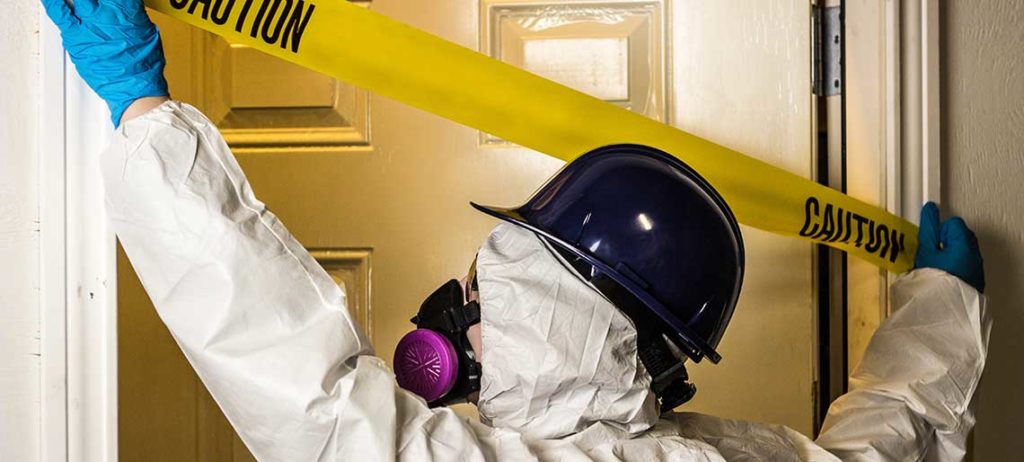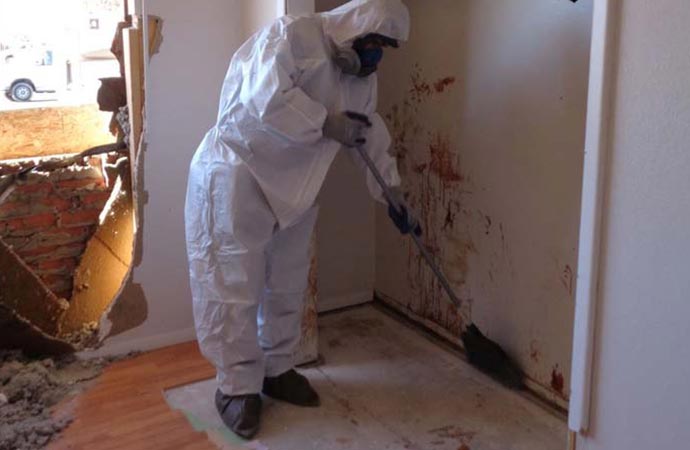Biohazard Removal: Safe Handling and Disposal of Hazardous Products
Biohazard Removal: Safe Handling and Disposal of Hazardous Products
Blog Article
Specialist Biohazard Cleaning and Purification for Blood, Bodily Fluids, and Hazardous Materials
The potential wellness dangers connected with exposure to biohazards underscore the vital demand for thorough handling and complete clean-up. As we navigate the complex landscape of biohazard cleaning, recognizing the nuances of policies, compliance, and the specialized devices at play comes to be essential in making certain a secure and extensive decontamination process.
Health And Wellness Dangers of Biohazard Direct Exposure
Exposure to biohazards postures substantial wellness risks that can lead to extreme consequences for areas and individuals alike. Biohazards include a vast array of organic substances, including blood, physical fluids, mold, germs, infections, and various other possibly transmittable products. When people come right into call with these biohazards, whether with crashes, incorrect handling, or ecological exposure, they encounter the risk of contracting major illnesses or illness.
One of the key wellness dangers related to biohazard direct exposure is the transmission of contagious conditions. Bloodborne virus such as HIV, hepatitis B and C, and different germs can be existing in biohazardous materials, positioning a direct threat to human health. Breathing in airborne biohazards like mold and mildew spores or entering contact with infected surface areas can likewise result in respiratory issues, allergies, and other negative health and wellness results.
Moreover, biohazard exposure can have lasting wellness implications, with some diseases materializing years after the first contact (Blood Cleanup). As a result, it is important to prioritize appropriate biohazard cleansing and decontamination to mitigate these wellness threats and make certain the safety and security of people and communities

Specialized Training for Biohazard Cleanup
When it involves handling biohazard cleanup efficiently and safely, specialized training plays a fundamental function in guaranteeing appropriate purification procedures are adhered to. Biohazard cleanup calls for particular understanding and skills to effectively minimize dangers connected with bloodborne microorganisms, physical liquids, and hazardous materials. Specialists learnt biohazard clean-up go through strenuous guideline on just how to safely manage, eliminate, and take care of biohazardous materials to avoid contamination and exposure.
Specialized training for biohazard cleaning covers an array of vital subjects, including proper individual safety equipment (PPE) use, bloodborne pathogen understanding, decontamination techniques, and contaminated materials disposal procedures. People learnt biohazard cleanup are outfitted with the required experience to evaluate contamination degrees, determine possible risks, and carry out suitable cleaning procedures in compliance with governing criteria.
Constant training and education are paramount in the field of biohazard cleaning to stay updated on the most recent decontamination innovations, safety procedures, and laws. By investing in specialized training, biohazard clean-up experts can properly react to emergency situation cleanup scenarios and guard both public health and wellness and the setting.
Relevance of Proper Purification Methods
Using appropriate decontamination techniques is critical in biohazard cleaning to efficiently minimize and remove unsafe products health and wellness threats. Effective decontamination not just ensures the elimination of visible traces of blood, physical fluids, and various other biohazards however additionally targets unnoticeable virus that might position significant health threats otherwise properly gotten rid of. By following rigorous decontamination methods, educated home professionals can considerably minimize the danger of exposure to harmful bacteria, viruses, and microorganisms that could result in diseases or infections.
Correct purification techniques entail the use of specific equipment and anti-bacterials that are specifically designed to reduce the effects of biohazards effectively. Comprehensive cleansing and disinfection of contaminated areas are vital to protect against the spread of virus and make sure a secure atmosphere for residents. Additionally, the appropriate disposal of biohazardous waste following decontamination treatments is vital in preventing contamination of various other surface areas or individuals.

Tools and Devices for Safe Clean-up
When dealing with blood, bodily fluids, or dangerous products, biohazard cleaning experts rely on specialized gear to minimize exposure threats and thoroughly sanitize the damaged location. Furthermore, biohazard cleaning sets consisting of anti-bacterials, absorbing products, and biohazard bags are used to securely include and dispose of contaminated things.
Advanced cleaning tools like hospital-grade anti-bacterials, HEPA-filtered vacuum cleaners, and misting machines are used to disinfect surface areas and remove biohazards successfully. Specialized equipment such as sharps containers and biohazard waste disposal containers are made use of to safely take care of sharp objects and biohazardous waste materials. By utilizing the best devices and devices, biohazard cleaning specialists can ensure a detailed clean-up procedure that prioritizes safety and viscera cleanup detail biohazard barrels lessens health and wellness threats for both workers and owners of the damaged room.
Regulations and Compliance in Biohazard Cleansing
Correct adherence to laws and compliance criteria is paramount in biohazard cleaning to make certain the security of both workers and the atmosphere. Government companies such as OSHA (Occupational Safety and Health Administration) and the EPA (Epa) have actually developed particular standards for biohazard cleanup treatments to lessen health risks and environmental contamination. These guidelines cover an array of facets consisting of the handling, transportation, and disposal of biohazardous products, as well as the necessary training and protective tools needed for workers associated with the cleanup procedure.
Biohazard cleansing business must stay up-to-date with these policies to assure that their procedures meet the called for safety and security criteria. Failing to follow these guidelines can cause extreme repercussions, including penalties, lawsuit, and jeopardizing the health and wellness of people and the atmosphere. By adhering to rigorous guidelines and conformity actions, biohazard cleansing companies can properly reduce threats and ensure a comprehensive and secure cleanup procedure for all celebrations entailed.
Final Thought
In verdict, biohazard cleaning you could look here and decontamination require customized training, appropriate methods, and adherence to policies. Direct exposure to blood, bodily fluids, and dangerous products positions significant wellness dangers, making it essential to make use of the best devices and devices for risk-free clean-up. By adhering to rigorous protocols and guidelines, specialists can efficiently minimize the threats connected with biohazard exposure and ensure the safety and security of both themselves and others.
As we navigate the intricate landscape of biohazard cleanup, comprehending the nuances of laws, compliance, and the customized equipment at play comes to be necessary in making certain a risk-free and extensive decontamination procedure. (Blood Cleanup)
When it comes to handling biohazard cleaning effectively and securely, specialized training plays a fundamental role in guaranteeing appropriate purification procedures are followed.Utilizing correct decontamination techniques is critical in biohazard clean-up to properly lessen and eliminate hazardous products health and wellness risks. In addition, biohazard cleaning packages including anti-bacterials, absorptive materials, and biohazard bags are utilized to safely get rid of and have of infected items.
Government firms such as OSHA (Occupational Security and Health Management) and the EPA (Environmental Defense Company) have actually established certain guidelines for biohazard cleanup treatments to lessen wellness risks and ecological contamination.
Report this page